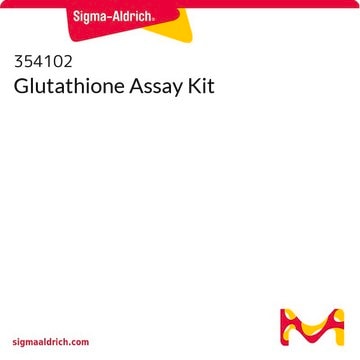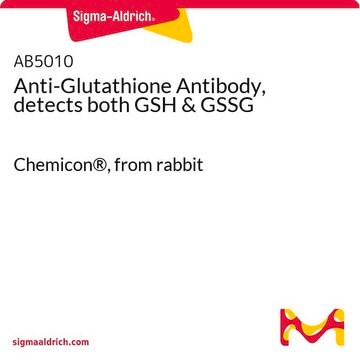CS0260
Glutathione Assay Kit
sufficient for 700 assays
Synonym(s):
GSH Quantification Test
Sign Into View Organizational & Contract Pricing
All Photos(2)
About This Item
UNSPSC Code:
12161503
NACRES:
NA.84
Recommended Products
General description
The kit provides all reagents for simple and quick assay to measure the level of total glutathione (GSSG + GSH) in a cell and tissue extracts and in red blood cells or plasma. The sample is first deproteinized with the 5% 5-sulfosalicylic acid solution. Glutathione content of the sample is then assayed using a kinetic assay in which catalytic amounts of glutathione cause a continuous reduction of 5,5′-dithiobis-(2-nitrobenzoic) acid (DTNB) to TNB. The oxidised glutathione formed is recycled by glutathione reductase and NADPH. The product, TNB, is assayed colorimetrically at 412 nm.
Application
Glutathione Assay Kit has been used to measure total glutathione concentration in glutathione assay. It also has been used to determine different oxidative stress parameters in rats.
Biochem/physiol Actions
Glutathione (GSH) functions as a cofactor for several antioxidant enzymes. It is involved in the regeneration of vitamins C and E. It modulates cellular proliferation and apoptosis. GSH is crucial for mitochondrial functioning and the maintenance of mitochondrial DNA (mtDNA). Mutations in this gene are associated with Alzheimer′s, Parkinson′s and Huntington′s diseases. It is also linked to cystic fibrosis, immune diseases and cardiovascular diseases.
Reduced glutathione (GSH), a tripeptide (g-glutamyl-cysteinylglycine), is the major free thiol in most living cells and is involved in many biological processes such as detoxification of xenobiotics, removal of hydroperoxides, and maintenance of the oxidation state of protein sulfhydryls. It is the key antioxidant in animal tissues
Features and Benefits
- A quick and simple method
- The kit contains all the reagents required for a colorimetric assay of total glutathione (oxidised + reduced GSSG + GSH)
- The kit includes a deproteination reagent for biological samples
Kit Components Only
Product No.
Description
- Assay Buffer 5x 30 mL
- DTNB 8 mg
- DMSO 7.5 mL
- Glutathine Reductase 20 U
- L-Glutathione Reduced 300 μg
- NADPH 25 mg
- 5-Sulfosalicylic Acid 2.5 g
related product
Product No.
Description
Pricing
Signal Word
Danger
Hazard Statements
Precautionary Statements
Hazard Classifications
Eye Dam. 1 - Resp. Sens. 1 - Skin Corr. 1B
Storage Class Code
8A - Combustible corrosive hazardous materials
Flash Point(F)
188.6 °F
Flash Point(C)
87 °C
Certificates of Analysis (COA)
Search for Certificates of Analysis (COA) by entering the products Lot/Batch Number. Lot and Batch Numbers can be found on a product’s label following the words ‘Lot’ or ‘Batch’.
Already Own This Product?
Find documentation for the products that you have recently purchased in the Document Library.
Customers Also Viewed
Assay of glutathione, glutathione disulfide, and glutathione mixed disulfides in biological samples.
T P Akerboom et al.
Methods in enzymology, 77, 373-382 (1981-01-01)
Rat testicular impairment induced by electromagnetic radiation from a conventional cellular telephone and the protective effects of the antioxidants vitamins C and E
Al-Damegh MA
Clinics, 67(7), 785-792 (2012)
Maria Swastika et al.
Malaria journal, 19(1), 208-208 (2020-06-20)
Glucose-6-phosphate dehydrogenase (G6PD) deficiency is the most common enzyme disorder in the world. Its main function is to generate NADPH that is required for anti-oxidative pathway in the cells especially in red blood cells (RBC). G6PD deficiency is X-linked and
Nicol M Caplin et al.
Frontiers in plant science, 11, 389-389 (2020-05-01)
The effects of ionising radiation (IR) on plants are important for environmental protection but also in agriculture, horticulture, space science, and plant stress biology. Much current understanding of the effects of IR on plants derives from acute high-dose studies but
Genotoxicity of hydroquinone in A549 cells
Peng C, et al.
Cell Biology and Toxicology, 29(4), 213-227 (2013)
Our team of scientists has experience in all areas of research including Life Science, Material Science, Chemical Synthesis, Chromatography, Analytical and many others.
Contact Technical Service





